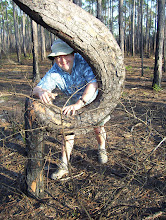 We hit the road again, down the South Fulton to Cochran Mill, and soon thereafter onto the entrance road to Cochran Mill Nature Center. We parked the vehicles, and set off down the trail to a couple of granite pavement outcrops in the adjacent Cochran Mill County Park. This was a different experience -- walking atop the rock, rather than looking at it up above you, from a viewpoint at the base of a roadcut exposure. Here, we could see more of the granite itself, locating enormous feldspar phenocrysts and even noting a slight orientation to them, a flow foliation resulting from the very slow rate of movement (akin to silly putty) of the gradually solidifying granitic magma. It is easy to imagine walking on the very top of a pluton (body of granite), but Julie reminded us that granite weathers by exfoliation, peeling off in layers like an onion, a process caused by the removal of all the overlying material. In fact, the actual pluton would have been much less smooth, and much more irregular, with fingerlike protrusions of granite penetrating adjacent rock units.
We hit the road again, down the South Fulton to Cochran Mill, and soon thereafter onto the entrance road to Cochran Mill Nature Center. We parked the vehicles, and set off down the trail to a couple of granite pavement outcrops in the adjacent Cochran Mill County Park. This was a different experience -- walking atop the rock, rather than looking at it up above you, from a viewpoint at the base of a roadcut exposure. Here, we could see more of the granite itself, locating enormous feldspar phenocrysts and even noting a slight orientation to them, a flow foliation resulting from the very slow rate of movement (akin to silly putty) of the gradually solidifying granitic magma. It is easy to imagine walking on the very top of a pluton (body of granite), but Julie reminded us that granite weathers by exfoliation, peeling off in layers like an onion, a process caused by the removal of all the overlying material. In fact, the actual pluton would have been much less smooth, and much more irregular, with fingerlike protrusions of granite penetrating adjacent rock units.We noticed joints -- cracks in the granite where no lateral motion has occurred. These were probably release joints, formed as the overlying rock eroded away. At a number of spots along one of the joints, solution pits had formed in the rock; some were empty, others still held water, and one even held a pine tree. Julie explained to us how the fine red soil in those more vegetated solution pits was probably not transported there from elsewhere on the rock face, but instead formed right there, through chemical and biological weathering processes. That clay originated as feldspars in the granite, now weathered into fine grains, deep enough in places for a loblolly pine to take hold. An ecological successionist would describe the solution pit development as a succession sequence, from bare rock to solution pit to pit with lichens and mosses to pit collecting soil to pit with loblolly pine. This process as I am describing it here has, no doubt, happened many times in such outcrop environments; but the story does not end there. The pines get tall, are blown over by the wind, and the soil on their roots washes away, leaving bare rock again....

I was distracted from my reveries by two round objects in the pine's branches. They turned out to be two beautiful tiny pots, still sealed shut, the living places of the larvae of potter's wasps. I was struck by how the clay had been reworked; the same feldspars, broken down into soil, were reanimated, made into a home for an insect. We are not the only organisms who build elaborate structures, using the natural environment as source of raw materials, and perhaps even inspiration.


No comments:
Post a Comment